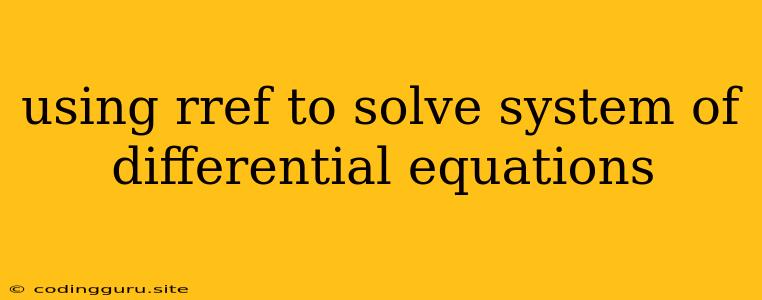Using RREF to Solve Systems of Differential Equations
Solving systems of differential equations can be a complex task, but utilizing the Reduced Row Echelon Form (RREF) provides a systematic and elegant approach. This method allows us to transform the system into a simpler form, making it easier to find the solutions.
What are Systems of Differential Equations?
A system of differential equations involves multiple equations, each containing derivatives of different unknown functions. For instance, a simple system might look like:
dx/dt = 2x + y
dy/dt = -x + 3y
Here, we have two unknown functions, x(t) and y(t), with their derivatives. The goal is to find the general solution for both functions.
How does RREF help?
The RREF method is a powerful tool in linear algebra. It transforms a matrix into a simplified form where:
- Each leading entry (the first non-zero element in each row) is 1.
- Each leading entry is the only non-zero entry in its column.
- All rows consisting entirely of zeros are grouped at the bottom.
This method can be applied to the matrix representation of the system of differential equations to simplify the system and find the solutions.
Steps to Solve using RREF:
-
Write the system in matrix form:
- Represent the derivatives and functions as a matrix. For example, the above system becomes:
d/dt [x y] = [2 1] [x y] [-1 3]- This can be written as:
X' = AXwhere X' is the derivative vector, A is the coefficient matrix, and X is the vector of unknown functions.
-
Find the eigenvalues and eigenvectors of A:
- Solve the characteristic equation det(A - λI) = 0 to find the eigenvalues (λ).
- For each eigenvalue, find the corresponding eigenvector by solving the equation (A - λI)v = 0.
-
Construct the general solution:
- For each eigenvalue, the general solution takes the form:
X(t) = c₁v₁e^(λ₁t) + c₂v₂e^(λ₂t) + ...where c₁ and c₂ are constants, v₁ and v₂ are the eigenvectors, and λ₁ and λ₂ are the eigenvalues.
-
Apply initial conditions (if given):
- Substitute the initial conditions into the general solution to determine the constants.
Example:
Let's solve the system of differential equations we introduced earlier:
dx/dt = 2x + y
dy/dt = -x + 3y
-
Matrix Form:
X' = AXwhere:
- X' = [dx/dt, dy/dt]
- A = [2 1] [-1 3]
- X = [x, y]
-
Eigenvalues and Eigenvectors:
-
det(A - λI) = 0:
|2 - λ 1| = (2 - λ)(3 - λ) + 1 = 0 |-1 3 - λ|Solving, we get λ₁ = 1 and λ₂ = 4.
-
Eigenvector for λ₁ = 1:
(A - I)v₁ = 0 [1 1] [v₁₁] = [0] [-1 2] [v₁₂] = [0]Solving, we get v₁ = [1, -1].
-
Eigenvector for λ₂ = 4:
(A - 4I)v₂ = 0 [-2 1] [v₂₁] = [0] [-1 -1] [v₂₂] = [0]Solving, we get v₂ = [1, 2].
-
-
General Solution:
X(t) = c₁[1, -1]e^(t) + c₂[1, 2]e^(4t)This gives us the individual solutions:
- x(t) = c₁e^(t) + c₂e^(4t)
- y(t) = -c₁e^(t) + 2c₂e^(4t)
-
Initial Conditions (Optional):
- If we were given initial conditions like x(0) = 1 and y(0) = 0, we could substitute them into the general solution and solve for c₁ and c₂.
Conclusion:
Using RREF to solve systems of differential equations provides a structured and efficient approach. By transforming the system into its matrix form, finding eigenvalues and eigenvectors, and constructing the general solution, we can systematically obtain the solution for each function within the system. This method is particularly helpful when dealing with complex systems, as it simplifies the process and offers a clear path to obtaining the desired results.
